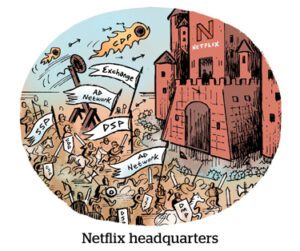Programmers that held upfronts came bearing gifts for advertisers, most of which were packaged as improvements to ad targeting and/or buying.
Netflix, Disney and Warner Bros. Discovery (WBD) all touted better ad targeting capabilities for streaming in response to a heightened focus on programmatic buying. And YouTube said it will launch unskippable 30-second spots on YouTube TV to convince buyers its impressions are premium.
Meanwhile, the Writers Guild of America (WGA) protests continue, which caused Netflix to hold its event virtually instead. Other media companies held in-person upfronts but kept their celebrity showcasing to a minimum (except, of course, for YouTube, which isn’t known for the scripted Hollywood production model the WGA is protesting). NBCUniversal, Disney and WBD all took extra care to emphasize their respect for journalism and/or the WGA itself.
Without celebrity glamor, programmers put a sharper focus on their ad offerings this year, according to some media buyers.
Fixed on Netflix
Last week, Netflix announced that advertisers will be able to buy sponsorship deals as part of its upfront package, which allows brands to buy the pre-roll spot before a title of their choice. The streamer will also time certain campaigns around holidays.
The targeting updates come on the heels of Netflix’s recent announcement about the private marketplace it built on Microsoft’s ad sales platform, which should make it easier for more advertisers to access these ad offerings from Netflix.
Most of Netflix’s rivals already offer sponsorship deals and programmatic buying, but these are pretty big steps for the streamer, as it embraces increased competition.
Peter Naylor, Netflix’s new VP of global ad sales, who came over from Snap in August, bragged that viewers are four times more likely to take an action based on an ad they saw on Netflix than on other streaming services, according to numbers from outcome-based measurement provider EDO.
But Naylor called out Disney specifically, likely because both companies launched ads within a month of each other. He therefore likely recognizes that advertisers are keeping a close eye on how the two services square up in terms of ad offerings.
Speaking of Disney, its priorities were similar to Netflix: better targeting and more programmatic.
Targeting with age and gender on Disney+ might be more advanced than Netflix’s genre- and country-based offering, but it’s still pretty basic. Disney is heavily focused on making Hulu’s more advanced ad targeting capabilities available on Disney+, which will happen over the summer, said Rita Ferro, Disney’s chief of ad sales and partnerships.
Ferro added that Disney’s audience graph, which includes recent integrations with third-party identity providers, is at the forefront of the company’s strategy to offer more precise targeting.
Disney is also using its audience graph to make more headway in programmatic ad sales. One in three Disney advertisers currently buy inventory programmatically, up from one in four advertisers last year. “Every single upfront deal [this season] will have programmatic at its core,” Ferro said.
Bundled up
WBD announced WBD Stream at its upfront, an advertising platform that lets advertisers buy against the company’s digital portfolio in one place, including channel apps such as Food Network and TNT. The new platform is available through both direct and programmatic deals.
WBD Stream has a similar purpose as NBCUniversal’s One Platform, designed to put all its inventory in one place for more efficient ad buying.
One Platform also includes linear inventory, but NBCU focused more on streaming during its upfront. Advertisers using One Platform can increase incremental reach and lower ad frequency by seeing all their NBCU buys in one place.
On the bundling front, WBD is also consolidating its ad tech to optimize reach and frequency for buyers by combining its addressable and data-driven linear tech stacks, which were separate before the merger.
For WBD, the timing for a fully unified ad platform makes sense considering it’s gearing up to launch Max this week, its new streaming service that combines HBO Max and Discovery+ content.
WBD isn’t the only one with bundling on the brain. Disney is also working on combining Disney+ and Hulu content in a “one-app experience” coming to the US later this year.
The bundling builds on Disney’s goal to expand Hulu ad targeting to Disney+. A full merge between Hulu and Disney+ seems all the more likely now that Comcast confirmed it’s probably going to sell its stake in Hulu to Disney next year.
On top of targeting and programmatic updates, some companies also made nods to measurement.
Netflix announced a partnership with EDO and confirmed that Nielsen’s digital ad ratings (DAR) will be available to advertisers starting in Q4.
When Netflix first launched ads, it chose Nielsen for audience measurement and both DoubleVerify and Integral Ad Science (IAS) for ad verification. But the streamer wasn’t ready for advertisers to actually use those measurement partners when it first launched ads.
This year, Netflix advertisers will get access to audience measurement with Nielsen’s DAR in addition to outcome measurement from EDO, including brand lift, search impact, conversions and unique reach. DoubleVerify and IAS also each released separate ad verification dashboards for Netflix advertisers earlier this year.
TV currency wasn’t a through line during this year’s upfront season, but it’s no secret that most streamers are moving away from Nielsen as a basis for valuing audience counts.
WBD emphasized alternative currencies in its upfront, confirming that it’s transacting against both Comscore and VideoAmp for the first time, in addition to Nielsen. NBCU is also transacting on alt currencies this year, and Disney is using measurement alternatives, albeit not as currency.
Currency is a hot debate within the TV industry, but just like targeting, programmatic buying and measurement, every current trend in connected TV advertising points to where streaming’s future is going: big data.
Time – and advertiser budgets – will tell which programmer pitches resonated most with buyers this year. Stay tuned.

















